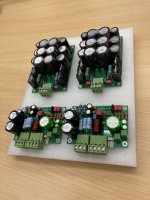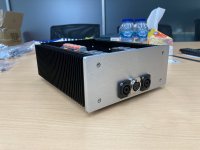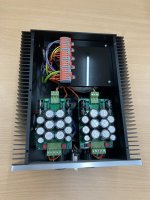Hi, I need some help to decide which resistor is the most suitable for the Thiele Output resistor for LM3886:
I only can found 3 type above in my local shop with the value and power rating needed
Thank You and any advice will be very appreciated.
- Metal Oxide
- Wirewound Silicone Coated (inductive)
- Wirewound Vitreous Enamel (inductive)
I only can found 3 type above in my local shop with the value and power rating needed
Thank You and any advice will be very appreciated.
Last edited:
Metal oxide, 2-5watt. I'm using 1.5ohm 2watt flame proof metal film resistor with 0.7uh coil without any issue.
Hello, finally I buy the metal oxide and wirewound silicone coated, still not decide which one to use, @nirupambhowmick Thank You for Your suggestion, and any other member here have the experience with other resistor and mind to share the information?
Thank You.
Thank You.
I thought nirupambhowmick's advice was clear and correct.still not decide which one to use
Hi PRR, yes after some reading I put the metal oxide one, Thank You for chiming in, I learn a lot from Your contribution here and another forum, really appreciate that.
You want a non-inductive resistor for the Thiele network. Its job is to conduct current at frequencies where the reactance of the output inductor exceeds the resistance of the resistor. You want a non-inductive resistor in the Zobel network as well for the similar reasons.
There are many non-inductive resistor types on the market. Metal oxide, metal film, metal foil, and also a few wire-wound types with Ayrton-Perry style winding. Between those types, the metal oxide (or MOX) type is the most prevalent so I'd go with that.
"Non-inductive" should be taken with a grain of salt. All resistors will have some inductance. Non-inductive should really be termed low-inductive. Most wire-wound resistors are quite inductive. I mean... Think about it. A wire wound resistor is basically an inductor with a ceramic core and a specified DC resistance.
Tom
There are many non-inductive resistor types on the market. Metal oxide, metal film, metal foil, and also a few wire-wound types with Ayrton-Perry style winding. Between those types, the metal oxide (or MOX) type is the most prevalent so I'd go with that.
"Non-inductive" should be taken with a grain of salt. All resistors will have some inductance. Non-inductive should really be termed low-inductive. Most wire-wound resistors are quite inductive. I mean... Think about it. A wire wound resistor is basically an inductor with a ceramic core and a specified DC resistance.
Tom
Even modern carbon film will work fine without any noticeable difference. The resistor 'value' is critical as far as i know. Anyway use min 1mm thick copper wire for the inductor coil, more is better.
Hi Tom, yes I understand a wire wound R basically is an inductor, when I make this post I have a thought that the output of the amp is gong to passive crossover and the first component for the tweeter crossover is wire wound resistor (after that also voice coil), after some read finally I realize that I should not confuse which part is belong to "AMP" and which part is belong to "LOAD". When I decide to try build this amp, I learn a lot from all Your post / guide here and also NEUROCHROME site, I'm Thankful to You for that, I attach the pic of the build (not finish yet)
Attachments
Hi nirupambhowmick Thank You for Your information and suggestion, and yes I already make the inductor with 1.2mm diameter wire
The resistor value is actually not super critical. Common values are in the range of 1-10 Ω. The purpose of the resistor is to dampen out the ringing caused by the resonance of the Thiele inductor and the load capacitance.Even modern carbon film will work fine without any noticeable difference. The resistor 'value' is critical as far as i know.
Tom
Understand Tom, I had read and learn about that from Your website before make this little amp and the component selection in my build had transition band around 58KHz and 25MHz, now the only problem is sourcing LM3886, really hard to find both TF and TThe resistor value is actually not super critical. Common values are in the range of 1-10 Ω. The purpose of the resistor is to dampen out the ringing caused by the resonance of the Thiele inductor and the load capacitance.
Tom
Last edited:
Hi, Thank You for the information, prefer to find locally first, will try Your link later
Finally got the chip, tested and assembled into case, the result (sound wise) is far beyond my expectation........ I should Thanks to this forum and forum members, especially @tomchr for all the information about LM3886, I learn a lot when build this little amp
Attachments
- Home
- Amplifiers
- Chip Amps
- LM3886 Thiele resistor type


